These iron-rich, easy-to-make turkey and lentil meatballs are a great first finger food option for baby-led weaning! Introducing a nice variety of tastes and textures between 6-9 months is important for oral-motor development, dexterity
and to widen a baby’s palate. These ground turkey meatballs are the perfect size and texture for a baby learning how to self-feed. They’re dietitian-approved and quick to make, too!
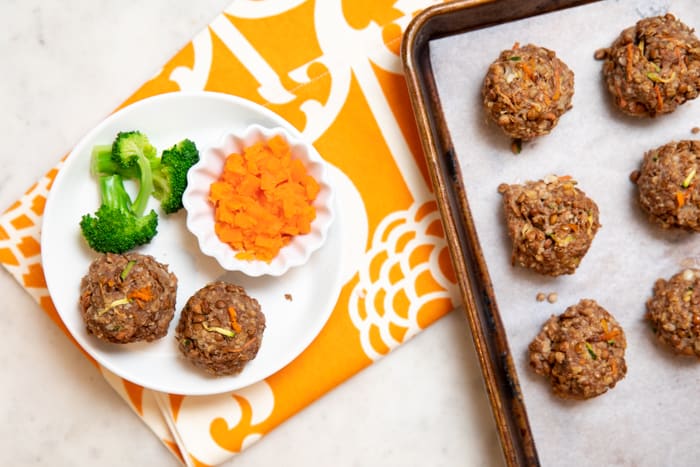
When you start your baby on solid foods, you may be wondering about the best food to start with (check out my beginner’s guide to baby-led weaning if you haven’t already!). There isn’t really a perfect choice. See, almost any food can be the right answer—it’s really up to you. For instance, you can start baby-led weaning with banana, or baby-led weaning with eggs. As a pediatric registered dietitian, I have seen parents start with a whole range of foods, none of which are necessarily “wrong”.
Traditionally, iron-fortified single-grain cereal thinned out with breastmilk or formula was the gold-standard first food for baby. Although it’s still an option, it is no longer the only starter-food choice. Notice in the recipe though, I did include the option of adding iron-fortified cereal to the ingredients (to boost iron and add texture). I often do this with finger foods because it’s a great way to add iron and use up baby cereal that hasn’t been used! In fact, these finger food recipes are perfect for baby.
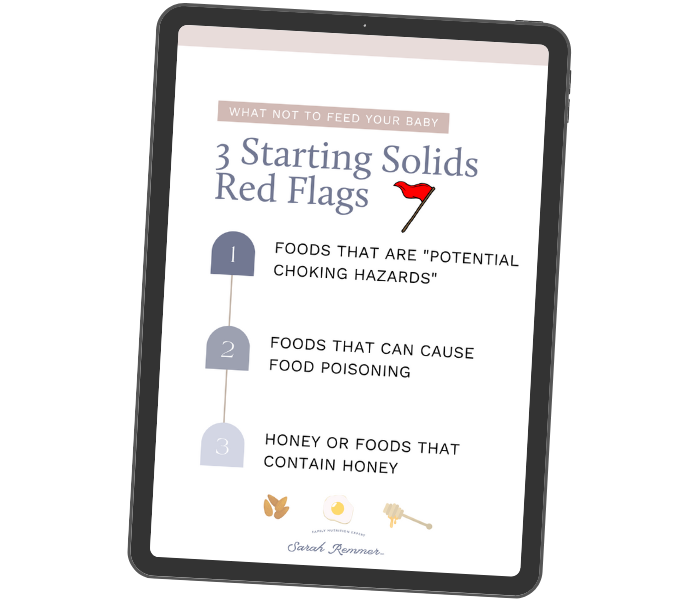
Starting solids? Don’t panic.
Starting solids is an exciting milestone in your baby’s life, but it can also be confusing, especially when you’re overloaded with conflicting information on how and when to do it. Download your free guide to starting solids and clear the confusion!
When can babies start eating meat?
Babies can start eating meat between 4-6 months of age, although as a registered dietitian, I recommend closer to the 6 month mark for any solid food, including meat. If you feel that your baby is ready (and they are showing signs that they are ready for solid foods) between 4-6 months of age, and you want to introduce meat, this is fine! Meat is an excellent source of many essential nutrients and can make for a great first food. Make sure that it’s fully cooked (braised, slow-cooked or boiled are all great ways to maintain moisture for most cuts of meat), and puree it with a bit of breastmilk or formula so that you can offer it via spoon in a responsive way (watching for and responding to baby’s hunger and fullness cues).
At 6 months of age (when I encourage parents to start solids), baby is ready for a variety of textures, including purees, minced, mashed, and soft, safe finger foods. This is when you can introduce larger, very soft pieces of fully-cooked meat that baby can bring to their mouth on their own using their palms. These turkey lentil meatballs (or any other baby-friendly meatballs) are a great choice because they are made with ground meat and soft lentils, which will easily break apart in baby’s mouth but are also firm enough that baby can self-feed (bring the food up to their mouths).
How should I introduce meat to my baby?
Although it sounds counter-intuitive, you can think about serving meat to baby this way (assuming baby is at least 6 months old): the younger your baby is, the bigger the piece of meat they should be served (remembering that it also needs to be soft enough to easily break apart in their mouths). I know–it sounds weird doesn’t it? But what this does is it allows baby to grab it with their palms, and hold onto it while chewing and sucking on it, without posing a choking hazard. If a young baby is offered small, cut up pieces of meat (I see this a lot from parents who are worried about choking), they can’t actually grab it on their own, or bring it to their mouths! That’s a recipe for a frustrated baby!
Serving meat for baby-led weaning: For babies 6-9 months, you will want to cut the meat into larger, 2-3 inch strips that are roughly the size a large eraser or two fingers OR offer soft meatballs that are the size of a pingpong ball or in the shape of a “finger”. Once baby is around 9 months, you can slice the meat thinner or into smaller pieces, or even shred it with two forks. Let baby self-feed by putting a few pieces of meat on the tray of their highchair (btw, here are my favourite baby-led weaning highchairs), so that they can grasp onto the pieces with their palms and bring it up to their mouths. For babies 6-9 months, meatballs or meatball “fingers”, drumsticks, ribs or very soft, moist larger pieces of cooked meat are good options. Slow-cooked shredded meat, or soft smaller or thinner pieces of meat, as mentioned above, can be served to babies by 9 months of age or so.
Pureed meat for baby: Meat purees are a great way for a young baby to be introduced to meat and its flavours and nutritional benefits. Pureed meat on its own has quite a strong flavour that not every baby will love. If your baby doesn’t seem to enjoy it on it’s own, you can combine it with some pureed fruit or a naturally sweet vegetable like pureed carrots or squash. Have your baby sitting properly in their highchair, watch for baby’s cues (opening their mouth), at which point you can bring a small spoonful of meat puree to their mouth. Wait until they open their mouths again before you bring the next spoonful up. You can also let baby grab onto the spoon themselves and help guide it into their mouths!
Can my baby choke on turkey meatballs?
The short answer here is probably not. A common concern is that baby will choke on solid foods. The long answer is that it depends on how you approach baby-led weaning. Of course, choking is serious business, and although it’s very rare, it’s important that you’re aware of common choking hazards and that you are prepared (i.e. take infant CPR and First Aid) just in case. But choking gets confused with gagging. To help clear the confusion and set your fears at ease, here is everything you need to know about choking and baby-led weaning!
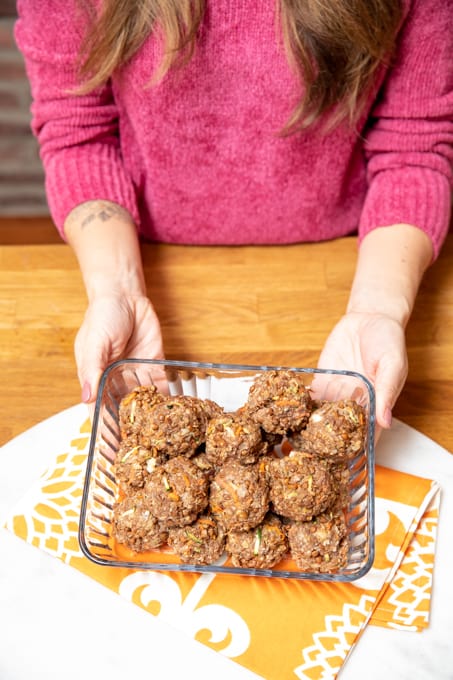
These meatballs are iron-rich
Iron-rich foods should be introduced right from the get-go (as soon as you start solids foods, around 6 months), as your baby’s iron needs increase around this time. The reason for this is that baby’s iron stores are depleted by 6 months of age (they were built up in the womb and lasted until 6 months of age). Babies between 6 and 12 months of age should be offered iron-rich foods at least twice a day. Things like tender pieces of meat or finely minced, ground, or mashed cooked meat, deboned fish, poultry, well-cooked whole egg, beans, and lentils are great first foods and iron-rich choices. These meatballs are also the perfect way to provide your baby with iron, among other important nutrients (like protein!).
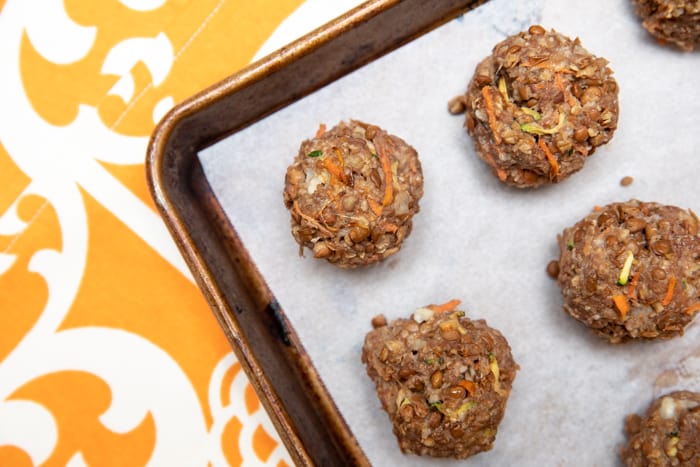
Protein is important for babies
Babies are in big-time growth in the first year of life, and protein is the building block for tissues such as muscles, organs, skin, and nails. It’s important that baby is getting enough every day. They’ll still be receiving a lot of it from breastmilk or formula, but it’s still important to offer protein-rich foods at most meals and snacks, such as meats, poultry, fish, beans, lentils, nut butters, seeds, tofu, full-fat Greek yogurt, and cheese. I included both ground turkey AND lentils in this recipe because both are chock-full of protein as well as iron (and many other important nutrients).
Introducing a nice variety of tastes and textures between 6-9 months is important for oral-motor development, dexterity and to widen their palate. These meatballs are the perfect size and texture for a baby learning how to self-feed.


Turkey and Lentil Meatballs for Baby-Led Weaning
These iron-rich, easy-to-make turkey and lentil meatballs are a great first finger food option for baby-led weaning! Introducing a nice variety of tastes and textures between 6-9 months is important for oral-motor development, dexterity
and to widen a baby’s palate. These ground turkey meatballs are the perfect size and texture for a baby learning how to self-feed. They're quick to make, too!
Ingredients
- 1lb of ground turkey (you can use any ground meat)
- 1 can lentils, drained and rinsed
- 1 cup rolled oats (you can substitute ½ of this for iron-fortified infant cereal if you have some that you have to use up)
- 2-3 eggs
- 1 cup grated or chopped veggies (I use a combo of grated carrot, chopped spinach, and grated zucchini)
- 1/2 cup parmesan cheese, grated
- 1 tsp garlic powder
- other dried herbs (optional)
Instructions
- Preheat oven to 400F and line or grease a baking sheet.
- Combine all ingredients in a large bowl and mix well with clean hands.
- Form into 24 medium-sized balls and place on a lined, greased, or non-stick baking sheet.
- Place in the oven and bake for 12-minutes, or until they reach an internal temperature of 170F.
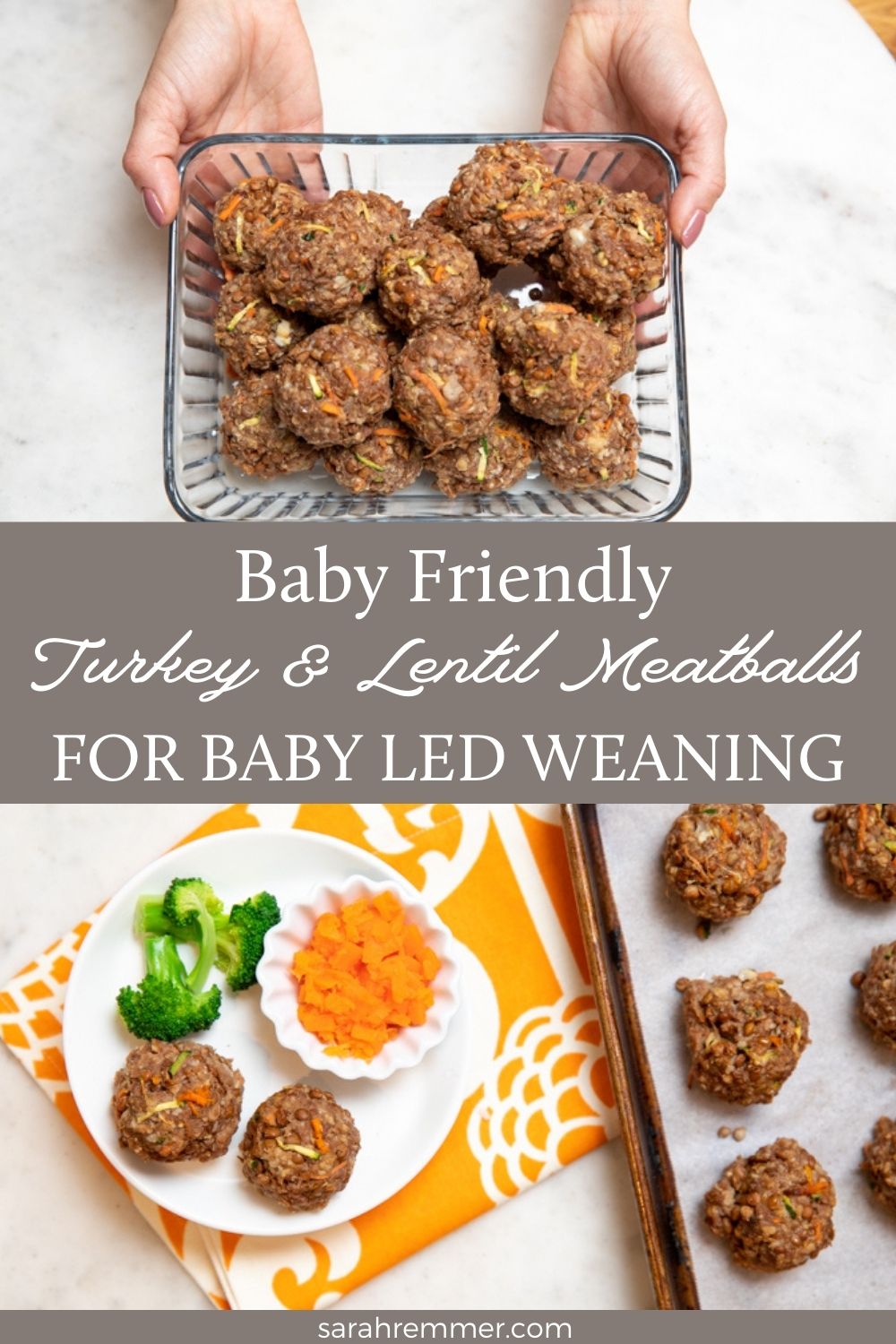
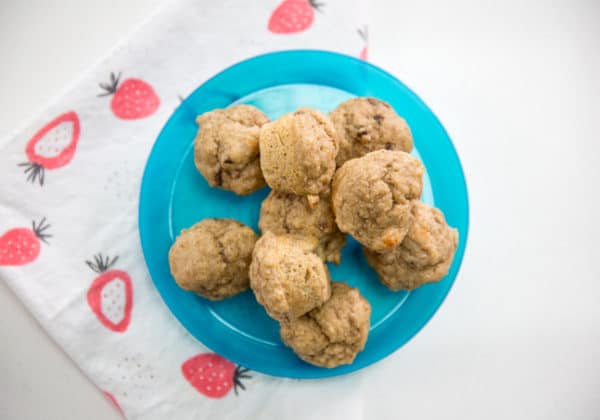


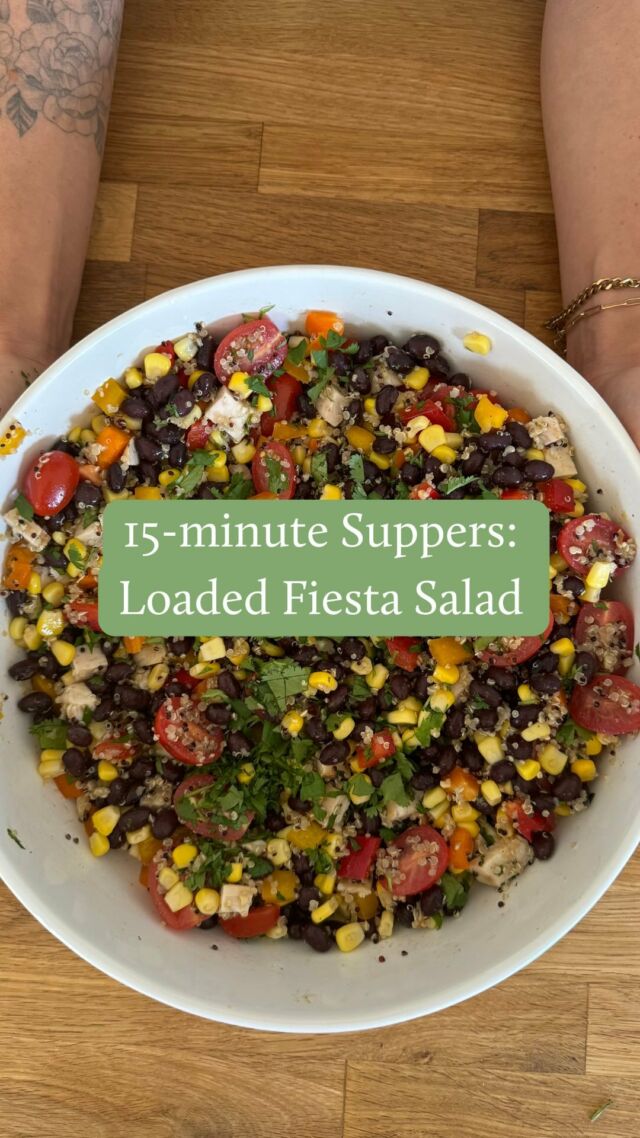



![[AD] It’s Day 6 of my 15-Minute Supper Series and today we’re putting a delicious twist on a classic BLT to make it nourishing and meal-worthy 🤤
Make sure to comment “Spud” and I’ll send you my top dietitian tips for feeding your family on busy weeknights along with a huge list of meal ideas!
This pasta salad takes no time at all to throw together and has everything you need for a nourishing meal. I always make extra bacon for things like this, but if you don’t have any cooked bacon I find cooking it in the airfryer or stovetop the quickest 🥓
I find that this salad lasts 2-3 days in the fridge without getting too soggy. You can also add in fresh lettuce to crisp it up or add the dressing when you eat it.
I ordered all of my groceries from @spuddelivers, which always saves me time and effort and gives me peace of mind knowing that I’m using high-quality, local and sustainable ingredients. I love that they come straight to my door the day after ordering 🙌🏻
Let’s make it!
Ingredients:
* 10 slices bacon cooked and diced
* 12 ounces pasta cooked and cooled
* 1 cup homemade Ranch dressing
* 1 ½ cup baby tomatoes diced
* ½ avocado diced
* feta
* ⅓ cup red onion diced
* 1 cup romaine lettuce
* fresh parsley for garnish optional
Homemade ranch dressing:
* ¾ cup mayonnaise
* ½ cup sour cream or Greek yogurt
* ½ teaspoon dried chives
* ½ teaspoon dried parsley
* ½ teaspoon dried dill weed
* ¼ teaspoon garlic powder
* ¼ teaspoon onion powder
* Salt and pepper to taste
Make it:
1. Blend all Ranch dressing ingredients together in a small blender (or whisk by hand) and set aside.
2. In a large bowl assemble the pasta, tomatoes, avocado, cheese, red onion, lettuce and bacon.
3. Pour the dressing over and toss to combine.
4. Garnish with parsley and serve.
You are going to LOVE this meal-worthy salad, I promise!
Comment SPUD to receive my top dietitian-approved tips for feeding your family during the week, a long list of ideas, and a curated shopping list with all of the ingredients for this recipe + all of the other ideas that I share in this resource!
#sponsored #spuddelivers #15minutemeals #whatsfordinner #easymealideas #dietitianapproved](https://www.sarahremmer.com/wp-content/uploads/sb-instagram-feed-images/438745920_798281295514125_2547899647147267180_nfull.jpg)
Comments
Carly Vanderhooft says
Hi there,
My son has an egg allergy, is there a good alternative to egg that could be used in this recipe? Thanks!
Sarah Remmer, RD says
Hi Carly, yes, you could make use chia or flax “egg”!
Tammi says
Hi! Can you use breadcrumbs instead of oats?
Sarah Remmer says
Hi Tammi! You definitely can :). Thanks for taking the time to be here!
Tina says
Hi Sarah
Have made your teething biscuits and mini banana muffins and they are a hit. Regarding these meatballs, for a vegetarian option, can I substitute the turkey with more lentils? How much would you suggest? Or any other ideas?
Thanks
Tina
Sarah Remmer says
Hi Tina! I’m so glad you loved these. For the vegetarian option, I would actually suggest giving my lentil nuggets a try! https://www.sarahremmer.com/kid-friendly-easy-vegan-lentil-nuggets/ Let me know how it goes.
RS says
If I’m using dry lentils, how much do I use? And do I have to cook then first then? (Sorry I’m new to cooking!)
Sarah Remmer says
Thanks for stopping by! I would highly recommend cooking the lentils first. You would follow the directions on the package. Red lentils cook the fastest. Alternatively, you can use rinsed and drained canned lentils.
Victoria says
Would these taste good without the parmesan cheese? We’re eating dairy free right now.
Sarah Remmer says
Yes, they would! You could even substitute the parmesan with some nutritional yeast for a cheesy flavour. Thanks for commenting!
Yjames says
Can I substitute a can of lentils If I cook then myself?
About how much is a can?
Sarah Remmer says
Yes you can! A 19 oz./540 mL can of lentils drained is approximately equivalent to two cups (500 mL) of cooked lentils.